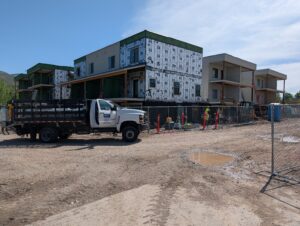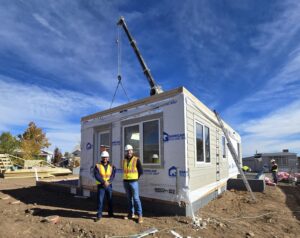Our very own Anthony J. Ries, AIA, LEED BD+C and Lisa A. Barter, RA, NCIDQ, LEED AP were recently interviewed for an article on Tubular Daylighting Devices. Their expertise in the area of daylighting coupled with prior articles written for www.EVstudio.com/blog brought the attention of magazine.
The article, written by Wanda Lau, can be read below:
Lighten Up
Tubular daylighting devices turn natural light into a deployable technology.
It’s quite the paradox: Daylight is one of our most abundant—and free—natural resources, yet, by enclosing ourselves in buildings, we spend as much as 38 percent of our electricity bills on artificial light. Introducing natural light into buildings can not only reduce energy use but also improve productivity, health, and even retail sales.
Windows and skylights have opened our rooms to sunlight, but heat gain, glare, and occasional water infiltration tagged along. The modern-day tubular daylighting device (TDD), invented in the mid-1980s, presented a way to collect, transport, distribute, and—perhaps most importantly—control daylighting using advanced technology in material science and physics.
HOW TDDS WORK
“The name of the game is to most effectively collect the daylight resource that you want,” says Neall Digert, vice-president of product enterprise at Solatube International, a TDD manufacturer in Vista, Calif. TDDs harvest daylight through a roof-mounted dome with diameters ranging from about 10 inches for residential applications to 22 inches for commercial buildings. Made from acrylic or polycarbonate formulated to block ultraviolet rays, the dome captures and redirects light rays into an aluminum tubing system that resembles ductwork.
The reflective surface inside the Solatube consists of multiple proprietary coatings that reject the undesirable wavelengths in the light spectrum: ultraviolet and infrared. The aluminum substrate dissipates the heat near the roofline while the remaining wavelengths—of visible light—reflect downward. In Solatube’s products, Digert says, only 0.3 percent of the light is lost with every bounce, allowing tubing systems to run more than 50 feet long and turn 90 degrees.
When the tubing system reaches the space to be lit, a fixture similar to a standard luminaire diffuses and distributes the light. Light output can be controlled with dimmers or supplemented with electric light as needed.
The ability to control daylight makes TDDs a viable option for spaces typically devoid of natural light, such as a building core and lower-floor levels, without creating areas of high visual contrast the way that skylights do. When New York–based LTL Architects renovated a facilities-maintenance building into an administrative office for Claremont University Consortium (CUC) in California last year, TDDs “allowed us a high degree of precision and control with the lighting that a traditional bubble skylight wouldn’t allow,” says LTL project manager John Morrison.
LTL and lighting designer Lumen Architects distributed 164 TDDs on the pitched roof of the one-story, 48,000-square-foot building, most of which were 21 inches in diameter. On average, the TDDs produce an output of 7,000 lumens, about the equivalent of eight 60-watt incandescent lamps or four 26-watt compact fluorescent lamps, says Nelson Jenkins, AIA, Lumen Architects principal. Custom acoustical baffles hung from the 12- to 22-foot-high ceiling disperse the natural light. “We wanted the movement of light, almost like there were clouds moving in the space,” Jenkins says. When light levels drop below 35 footcandles, an integrated building-management system automatically turns on supplementary fluorescent light equipped with dimmers.
At the Bagley Outdoor Classroom Building at the University of Minnesota Duluth, built in 2010, locally based architect David Salmela, FAIA, incorporated TDDs because the heat-loss factor of skylights didn’t meet the German Passivhaus standard. Two 12-inch-diameter TDDs light a 43-by-24-foot main room. The devices’ small aperture and integration into the roof’s insulation system resulted in little heat loss. “The tubes are remarkable, bringing in so much light with hardly being noticeable,” Salmela says. “You get the effect of the light but it isn’t glaring or a physical indention in the ceiling like a normal skylight.”
PLANNING GUIDELINES
TDDs can be an economic and effective way to light new and existing buildings. With a starting price of $500 a pop, however, the payback period could be many years. “It takes the right client to understand that this is not something that calculates with just a first-cost payback in a very short period of time strictly from an energy standpoint,” says Lisa Barter, founder of 3i Design, a lighting and design firm based in Denver.
The region’s climate will help determine what type of dome to use. In cloudy regions, a nearly transparent dome will allow in as much light as possible. In sun-filled regions, a dome with refractive lenses will block direct, heat-producing, overhead light while harvesting low-angled light.
Because the dome’s curvature collects daylight from all directions, a building’s orientation is less of a concern than are obstructions such as trees and parapet walls. Tubing extenders can raise the domes above the roof plane and out of shadows.
Anthony Ries, a project manager at Denver-based architecture and engineering firm EVstudio who has used TDDs in several residential projects, says that the area, height, and illuminance requirements of the intended space will help determine the TDD spacing and diameter. One TDD for every 300 square feet of coverage is a reasonable starting point, he estimates, but architects should consult a lighting designer and TDD manufacturing representative for more-accurate calculations.
The desired quality and variability of light are also considerations. At CUC, the combined illumination from the TDDs, windows, and fluorescent lights creates a “crazy range of colors that are essentially white,” Morrison says. However, the change in light quality occurs slowly enough for eyes to adapt.
For spaces with evening occupancy, supplemental electrical lighting is a must, Barter says. Architects also need to prepare their clients for the “dark spots in the ceiling at night where you’re used to seeing them illuminated.”
INSTALLATION CHALLENGES
Coordinating the design and installation of TDDs with other trades, including structural, M/E/P, and interiors, works best early in the design process. BIM software can help identify potential conflicts in new construction, but unknown conditions in walls and chaseways can make retrofits difficult. “You need to investigate and make sure there is room or alternatively create the space in areas it may fit,” Ries recommends.
To ensure the integrity and warranty of the roofing system, the general contractor and roofing contractor should work together to tie the TDD flashing into the roof’s waterproofing system. Proper installation of manufacturer-supplied flashing systems and details can reduce the risk of water infiltration.
Tubular daylighting devices provide astounding control of daylight from collection to diffusion. Though manufacturers are continually finessing their products, TDDs have made great strides in the quest to bring the outdoors inside.
The article can be found at: http://www.eco-structure.com/daylighting/lighten-up.aspx










